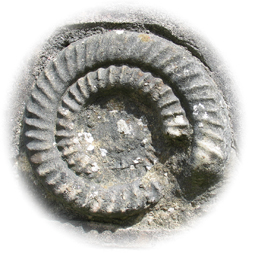Geology
The Bristol area has a complex geology that has given us features such as the Avon Gorge, the Cotswold escarpment, and the gentle rolling scenery around Saltford. The geology has helped to dictate human activities in the area - from the location of Roman settlements to some of the earliest coal mining in the world. This geology in turn, offers a rich and varied environment for wildlife and contains some unique species.

A geological cross section through Kingswood would reveal the layers of coal and sandstone that were horizontal when they were laid down 300 million years ago but have since been buckled and eroded.
Thin layers of mudstone and limestone, formed about 200 million years ago (Jurassic age), can be seen around Keynsham and Saltford. These Lias rocks are famous for their fossil shellfish and ammonites (left) which must have lived in a shallow muddy sea.
On the Bristol side of Bitton Station, the Railway Path passes through Cherry Garden cutting. Some of the first rocks to be seen in the cutting sides are Triassic and Jurassic in age. A few hundred metres further on the rocks change abruptly – these are the Pennant Sandstones of Carboniferous age, (approx 300 million years old). The reason for this sudden change is the result of a fracture in the earth's crust – a fault. This has moved the rocks on one side up relative to the younger rocks on the other side.
As the Path approaches Bath from Saltford, the steep slope of the Cotswold Escarpment can be seen rising on either side of the river. The high hills around the city are capped by the hard limestone which provides the Bath Stone used in most of the city’s buildings, while the steep valley sides are made of softer clays and sands. All these rocks contain the fossil remains of marine animals.
Find out more about the amazing geology along the Path with
Avon RIGS Group. A geological cross section through Kingswood would reveal the layers of coal and sandstone that were horizontal when they were laid down 300 million years ago but have since been buckled and eroded.
A geological cross section through Kingswood would reveal the layers of coal and sandstone that were horizontal when they were laid down 300 million years ago but have since been buckled and eroded. 

